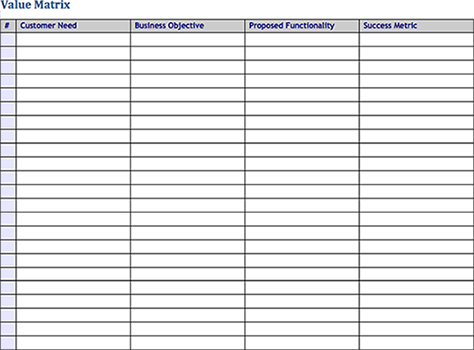I’ve tried—and seen other people try—a variety of solutions to this problem. In the worst case, a manager simply denied the problem existed, insisting that the research team’s responsibility was to understand the customer, not propose new functionality. I completely disagree with that assertion. Over the years and with the help of several colleagues, I have refined a deliverable that I think fills this gap: a Value Matrix.
I’m glad to report that each time my team or I have used the Value Matrix, the outcome was a very happy stakeholder or client.
What Is a Value Matrix?
A Value Matrix maps the value of your recommendations for features and services across business needs and defines the criteria by which you would judge each recommendation successful.
The Value Matrix communicates with product stakeholders and business owners in a language they understand. I’ve encountered many business people who have difficulty understanding how personas and scenarios apply to the product development process. While they understand there is value in creating the personas, using them is challenging for them.
In considering this problem, I’ve come to the conclusion that personas and scenarios represent only half of the equation that defines who our customers are. It’s possible to use this half of the equation in a variety of contexts throughout an entire business, but when the time comes to apply this deep understanding of your customer—far deeper than broad-stroke market research—to a particular product or service, there’s something missing.
The process of creating the Value Matrix can fill that gap. The Value Matrix succinctly communicates to all stakeholders the reason—not just the business objective, but also the specific customer need—for each feature or process. In essence, the Value Matrix provides a means of summarizing and applying your customer research.
The Value Matrix is not a magic bullet. It provides a summary of a variety of documents and assumptions already in existence. And it takes quite a bit of collaboration to create one.
The Value Matrix Template
Let’s look at the makeup of the Value Matrix template shown in Figure 1. You can download this template for a Value Matrix.

As you can see, the Value Matrix template comprises a simple table, consisting of five columns:
- Customer Need
- Business Objective
- Proposed Functionality
- Success Metric
- Priority
Let’s take one column at a time.
Customer Need
If you’ve just completed a round of customer research such as a contextual inquiry, interviews, or exploratory usability testing, you know a lot about your customers and their frustrations. You’ve probably turned all the information you’ve gleaned into high-level goals and even crafted a few scenarios around how users want to interact with the product or service. Great! Now, let’s dig a little deeper.
In the Customer Need column, list all the nuggets of information about what a user is trying to accomplish in relation to the product you’re building. There’s no need to explain why they want to accomplish each goal. (You’ll do that in your personas and scenarios.) Just explain what they need. If possible, use actual quotations or describe users’ actions and point to videos of user observations. If you have multiple data points that support a particular need, include them. Though, I’ve found three are enough to show there is a significant need, without overwhelming the business audience.
